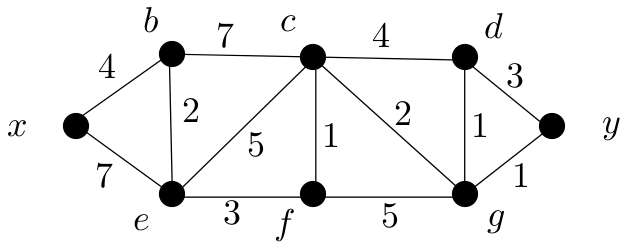TU Wien:Diskrete Mathematik für Informatik UE (Gittenberger)/Übungen WS13/Beispiel 21
Zur Navigation springen
Zur Suche springen
Use Dijkstra’s algorithm to determine d(x, y) in the following graph.
Solution[Bearbeiten | Quelltext bearbeiten]
| x | b | c | d | e | f | g | y | Node | Predecessor |
|---|---|---|---|---|---|---|---|---|---|
| 0 | ∞ | ∞ | ∞ | ∞ | ∞ | ∞ | ∞ | x | - |
| 4 | ∞ | ∞ | 7 | ∞ | ∞ | ∞ | b | x | |
| 11 | ∞ | 6 | ∞ | ∞ | ∞ | e | b | ||
| 11 | ∞ | 9 | ∞ | ∞ | f | e | |||
| 10 | ∞ | 14 | ∞ | c | f | ||||
| 14 | 12 | 15 | g | c | |||||
| 13 | 13 | d | g | ||||||
| 13 | y | g |
The shortest path from x to y is x-b-e-f-c-g-y with length 13.
